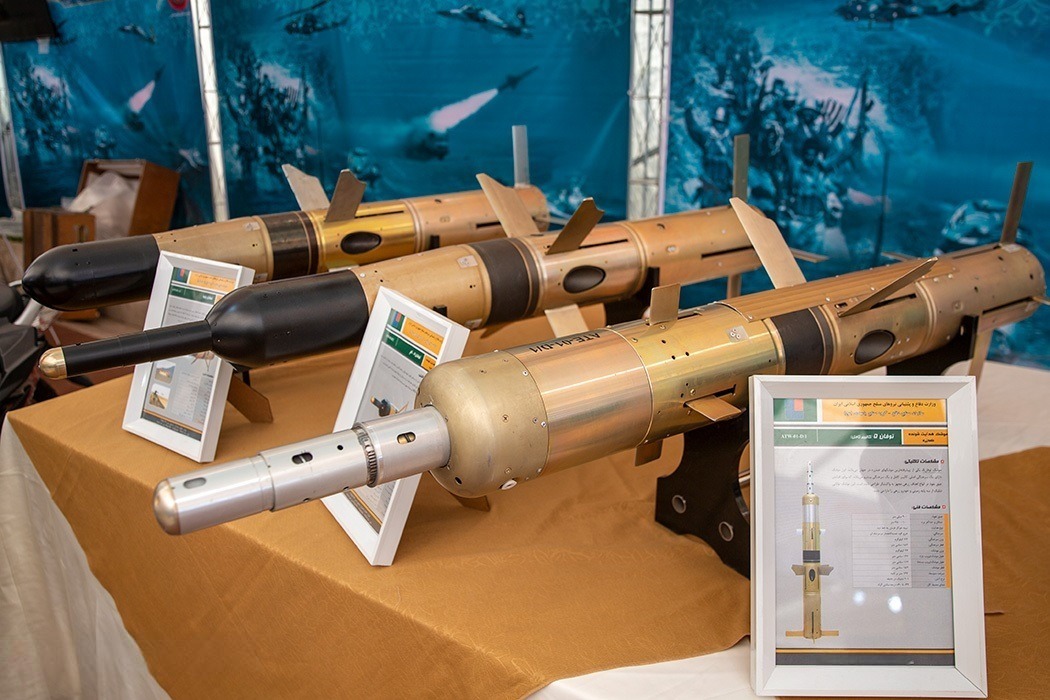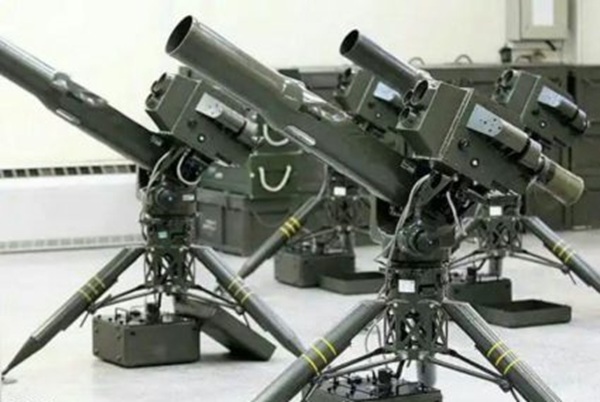The Possibility of Destroying the Great Tanks in the World with "Toophan" Anti-Armor Missiles
TEHRAN (Defapress) - Anti-tank missiles play a crucial role in the ground combat of armed forces, and the armed forces of the Islamic Republic of Iran possess various anti-armor missiles tailored to their needs.

These missiles are an effective factor in preventing the advance of enemy armored units and play a significant role in slowing down and stopping the movement of tanks, armored personnel carriers, and armored vehicles of any hostile army.
The development of anti-tank missiles in Iran dates back to the imposed war (Iran-Iraq War), during which early models of TOW anti-tank missiles were used to counter tanks and armored vehicles of the Ba'athist enemy. Initial models of TOW anti-tank missiles weighed approximately 18 kg and had a range of about three kilometers, but gradually, with the advancement of models, their range reached about four kilometers.
During the imposed war, and following the all-out aggression of the Ba'athist enemy against the Islamic homeland, the need for anti-tank missiles increased significantly. In this regard, the following two scenarios concerning TOW anti-armor missiles were put on the agenda:
- Purchasing these missiles from third-party countries.
- Assembling missile components to advance war efforts and counter tanks donated by the United States and the former Soviet Union to the Ba'athist regime.
After the imposed war, the development and production of anti-armor missiles entered a new phase. In this regard, the "Toophan" and "Almas" projects were proposed as strategic and viable projects. This report will examine the features of the "Toophan" projects.
Anti-tank missiles play a crucial role in the ground combat of armed forces, and the armed forces of the Islamic Republic of Iran possess various anti-armor missiles tailored to their needs.
These missiles are an effective factor in preventing the advance of enemy armored units and play a significant role in slowing down and stopping the movement of tanks, armored personnel carriers, and armored vehicles of any hostile army.
The development of anti-tank missiles in Iran dates back to the imposed war (Iran-Iraq War), during which early models of TOW anti-tank missiles were used to counter tanks and armored vehicles of the Ba'athist enemy. Initial models of TOW anti-tank missiles weighed approximately 18 kg and had a range of about three kilometers, but gradually, with the advancement of models, their range reached about 4 kilometers.
During the imposed war, and following the all-out aggression of the Ba'athist enemy against the Islamic homeland, the need for anti-tank missiles increased significantly. In this regard, the following two scenarios concerning TOW anti-armor missiles were put on the agenda:
- Purchasing these missiles from third-party countries.
- Assembling missile components to advance war efforts and counter tanks donated by the United States and the former Soviet Union to the Ba'athist regime.
After the imposed war, the development and production of anti-armor missiles entered a new phase. In this regard, the "Toophan" and "Almas" projects were proposed as strategic and viable projects. This report will examine the features of the "Toophan" projects.

Toophan Anti-Armor Missile
Toophan anti-armor missiles are used in the armed forces of the Islamic Republic of Iran in 2 models: Toophan-1 and Toophan-2. With its special capabilities, this type of missile can hit targets from a distance of about 4 kilometers; however, its effective range is approximately 3,500 meters. Additionally, Toophan-1 and Toophan-2 anti-armor missiles differ in their armor penetration capabilities. Despite both missiles weighing about 18 kg with a warhead weight of about 4 kg, they have different performances in terms of armor penetration. The Toophan-1 anti-armor missile penetrates about 550 mm into a tank's armor, while the Toophan-2 penetrates 760 mm, indicating a high probability of destroying enemy armored equipment if these missiles hit them.
However, Toophan-1 and Toophan-2 anti-armor missiles differ from the Kornet anti-armor missile in terms of armor penetration. Military analysts believe that the Kornet anti-armor missile, which was also used by Hezbollah fighters against the Israeli regime's army during the 33-day war, penetrates about 1,000 mm into armor, causing serious problems for Israeli army tanks in southern Lebanon. The July 2006 war showed that Hezbollah fighters, using tripod launchers for Kornet missiles (which are not dissimilar to Toophan missiles) with an operational range of 4 to 5 kilometers, turned the Khiam plain into a graveyard for Israeli regime army tanks.
The ISW website states that Iran was the first serious buyer of the BGM-71 TOW anti-armor missile in 1971, and its component assembly was seriously pursued in Iran in 1975. In 1979, coinciding with the victory of the Islamic Revolution in Iran, the United States did not allow Iran to assemble this missile, and the assembly project was halted simultaneously with the revolution's victory.
The website adds that with the start of the Iran-Iraq War in 1980, Iran, facing a concentrated attack by Ba'athist army tanks and armored vehicles, sought to purchase large quantities of TOW and Malyutka missiles from the black market, thus making the acquisition of anti-tank missiles a serious priority. The experience with this missile class is derived from the Sadid and Qaem missiles and their high accuracy. As mentioned, the Toophan missile is designed and produced based on the American-made BGM-71 TOW anti-armor missile. It also features a special tube inside that is placed on the launcher during firing.
The Toophan anti-armor missile can be fired from various launchers, including air-launched and ground-launched platforms. On ground launchers, the Toophan anti-armor missile can be mounted on armored vehicles in any configuration. Additionally, AH-1 helicopters can carry and accurately fire this missile. It is said that in the special Zolfaghar exercise, Toophan missiles were also fired with an air-to-surface launcher, and successful target hits were reported in this regard.
One of the most important features of an anti-armor missile is its ability to penetrate reactive armor, which can lead to a victorious battle for our country in the war zones. Reports indicate that the penetration of the Toophan anti-armor missile into reactive armors is very high.
The "ISW" website states in this regard: The penetration of Toophan-1 and Toophan-2 missiles into reactive armors ranges from 550 to about 760 mm. For example, the Toophan-2 missile was developed to increase the penetration rate, and by adding an extended probe penetrator and a heavier two-stage warhead, it not only increased armor penetration capabilities to about 760 mm but also gained the ability to overcome various types of reactive armor. The extended probe in the Toophan-2 missile has a small warhead to defeat reactive armor, allowing the main warhead to engage the main armor. The extended probe is located inside the missile and, after being fired from the tube, extends and serves as the missile's nose to strike targets.

Production of Various Toophan Anti-Armor Missile Versions
It is noteworthy that the Toophan anti-armor missile has not been offered only in two models, Toophan-1 and Toophan-2. According to reports from officials of Iran's Ministry of Defense and Armed Forces Logistics, 11 models of this anti-armor system have been developed. Brigadier General Seyed Mehdi Farahi, Deputy Minister of Defense and Armed Forces Logistics, states: "Annually, we undertake hundreds of improvement projects to upgrade product levels, and anti-armor missiles are among them."
He adds: "Using the same TOW missile base and platform, we have produced Toophan missiles in seven phases, from Toophan-1 to Toophan-7, and this process continues. Toophan missiles are defined up to version 11. Additionally, there are other missiles such as Saegh, Tondar, Tosan, Dehlavieh, etc., which can be launched from helicopters, platforms, and tanks."
Field reports indicate that the Toophan anti-armor missile has demonstrated outstanding performance in battlefields, with examples observed in regional and international conflicts. With its acceptable armor penetration capability, the Toophan anti-armor missile can be a killer of any tank on the battlefield.
The development of anti-armor missiles for the Islamic Republic of Iran Army Ground Force and the Islamic Revolutionary Guard Corps, as the backbone of these two important forces, can significantly increase their combat power. Furthermore, military exercises under harsh conditions using these advanced missiles can deter enemies from any covetousness.
If we were to mention the most important Western tanks that might be used in potential conflicts against Iran, we could point to the US Army's Abrams tank and the German Army's Leopard 1 and Leopard 2 tanks. These tanks are considered accessible prey against the Toophan anti-armor missile, as media sources indicate that more advanced versions of Toophan missiles can penetrate armor up to 800 and even 900 mm.
